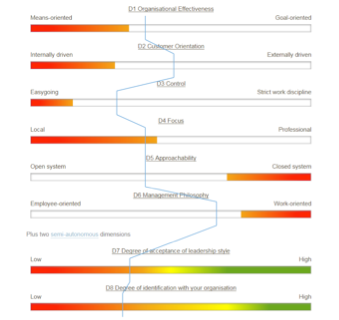Sign up for FlowVella
Sign up with FacebookAlready have an account? Sign in now
By registering you are agreeing to our
Terms of Service
Loading Flow

Research Hofstede
The Hofstede Organisational Culture Model is based on the research by Sanders and Neuijen in ten companies in the Netherlands and Denmark. This resulted in six dimensions for describing organisational cultures. These six create already a more complex picture than a typology based on two axes. In addition, the commercial application of this theory adds two semi-autonomous dimensions and links the theory to strategy and change management.
Dimension 1: effectiveness and 2
■ means oriented: ways of doing
things and how they are done
■ goal oriented: realizing goals and
what needs to be realised
Dimension 2: customer orientation
■ internal focus: honesty and
knowing what is best for the
customer
■ external focus: do what the client
wants, results, pragmatic
Dimension 3: control
■ loose working discipline: loose
structure, low predictability,
limited control and discipline, lots
of improvisation
■ tight working discipline: opposite
of loose
Dimension 4: social control
■ local: short term, internally
oriented, strong social control
■ professional culture (opposite)
Dimension 5: attitude towards
outsiders
■ open system: outsiders welcome,
everybody fits in
■ closed system
Dimension 6: management philosophy
■ focus on people: taking the
personal problems of staff into
account
■ focus on work: putting much
pressure on people to deliver their
work in time
Dimension 7: Leadership
■ Autocratic
■ Paternalistic
■ Consultative
■ Democratic
Dimension 8: Identification with the
organisation
■ degree of feeling fitting in in the
organisation
